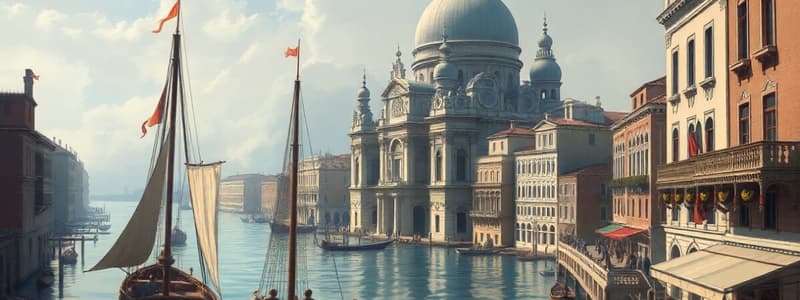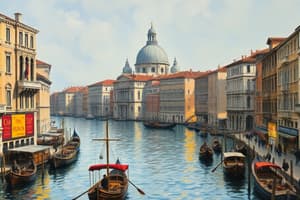Podcast
Questions and Answers
What was a primary mode of transportation in Venice?
What was a primary mode of transportation in Venice?
- Bicycles
- Boats and rivers (correct)
- Trains
- Automobiles
In which century did Venice control much of the Adriatic and Aegean Seas?
In which century did Venice control much of the Adriatic and Aegean Seas?
- 10th century CE
- 12th century CE (correct)
- 14th century CE
- 16th century CE
Which type of ship was primarily used by Venetian maritime fleets?
Which type of ship was primarily used by Venetian maritime fleets?
- Galleys (correct)
- Caravels
- Barks
- Brigs
What significant trade relationship did Venice establish in the Middle Ages?
What significant trade relationship did Venice establish in the Middle Ages?
What agreement was made between the Byzantine Emperor and the Venetians in 1082?
What agreement was made between the Byzantine Emperor and the Venetians in 1082?
What was a key factor in Venice's rise to power during the High Middle Ages?
What was a key factor in Venice's rise to power during the High Middle Ages?
What role did Venetian maritime fleets play in relation to the Byzantine Empire?
What role did Venetian maritime fleets play in relation to the Byzantine Empire?
How did the treaty signed in 1082 benefit the Venetians?
How did the treaty signed in 1082 benefit the Venetians?
What type of military presence was found on Venetian galleys?
What type of military presence was found on Venetian galleys?
What was the impact of Italy's geography on Venice's maritime trade?
What was the impact of Italy's geography on Venice's maritime trade?
Flashcards are hidden until you start studying
Study Notes
Venice's Rise to Power
- Venice is a city in Italy made up of over one hundred small islands.
- Instead of streets and cars, Venice uses rivers and boats for transportation.
- In the High Middle Ages, Venice was a wealthy and influential maritime power.
- Venice controlled much of the Adriatic and Aegean Seas in the 12th century CE.
Venice's Trading Empire
- Venice grew wealthy and powerful due to its trading relationships with Egypt and other Middle Eastern countries.
- Venetian maritime fleets, known as galleys, were large ships powered by over one hundred oarsmen.
- Galleys were armed with soldiers and served as protectors of the Byzantine Empire's seas.
- In 1082, the Byzantine Emperor Alexios I Komnenos signed a treaty with Venice.
- In exchange for Venetian help against the Normans, Venice gained free trade throughout the Byzantine Empire, without tariffs.
Venice's Influence
- Venice controlled important ports like Constantinople.
- The Venetians became Egypt's exclusive European trading partner for spices and other goods.
Venice's Maritime Power
- Venice is situated on over 100 small islands and utilizes canals and boats for transportation.
- In the High Middle Ages, Venice was a prominent maritime power, controlling significant parts of the Adriatic and Aegean Seas.
- Venetian wealth and influence stemmed from trade with Egypt and other Middle Eastern nations.
- Venetian galleys were large ships with over 100 oarsmen, manned by armed soldiers to combat pirates and protect the Byzantine Empire.
- The Venetian navy was instrumental in protecting Byzantine waters, becoming the empire's primary naval force.
- In 1082, a treaty between Venice and the Byzantine Emperor Alexios I Komnenos granted Venice free trade throughout the empire in exchange for Venetian assistance against Norman warriors.
- Venice established control over important ports such as Constantinople, further enhancing its trade dominance.
- Venice's strong relationship with Egypt led to its exclusive European trading rights for spices and other goods.
Studying That Suits You
Use AI to generate personalized quizzes and flashcards to suit your learning preferences.




